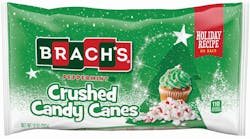When consumers think about confections, one color that often comes to mind is red. The color makes people think of heat, love and sweetness. And a great way to make that color in many applications is red dye No. 3, otherwise known as erythrosine.
PEZ candies, Betty Crocker Red Decorating Icing and countless other confections use red 3. But the dye is derived from petroleum and has been pegged as a possible carcinogen since the 1970s.
Similarly, titanium dioxide is a highly effective white colorant that is found in countless processed foods and beverages. In some applications it creates a bright white appearance, and in others it enhances other colors. But, as with erythrosine, questions exist about the safety of titanium dioxide as a food colorant.
“Increased public awareness of health and environmental concerns has driven demand for cleaner labels and natural ingredients,” notes Mark Hass, CEO of The Helmsman Group. “[That has] impacted consumer acceptance of red dye No. 3 and titanium dioxide.”
Roots of the problem
Erythrosine has been associated with a variety of health concerns, including behavioral issues in children. Perhaps most prominently, studies linked high doses of erythrosine to thyroid cancer. In 1990, the FDA banned the colorant in cosmetics, but allowed it to remain in many food applications. The state of California, however, did ban erythrosine – and three other food additives – in the Food Safety Act that passed last October. The ban takes effect in 2027.
The fact that the FDA allows red dye No. 3 and California does not presents a conundrum, of course, and the National Confectioners Assn. has come out against the new California law.
“They’re making decisions based on soundbites rather than science,” the association said in a statement. “Governor Newsom’s approval of this bill will undermine consumer confidence and create confusion around food safety. This law replaces a uniform national food safety system with a patchwork of inconsistent state requirements created by legislative fiat that will increase food costs…. We should be relying on the scientific rigor of the FDA in terms of evaluating the safety of food ingredients and additives.”
Titanium dioxide also lives in the netherworld between approval and banning. Some studies have concluded that the ingredient is totally nontoxic, yet others have shown that titanium dioxide dust is possibly carcinogenic.
The European Union banned titanium dioxide in food in 2022, and California had included a ban on it in the same bill that banned erythrosine, but dropped it before it was passed. A bill currently in committee at the New York state senate also would ban titanium dioxide – as well as red dye No. 3 -- in that state.
Regardless of the ultimate legal status of the two colorants, many consumers are looking for products without them. “Whether rooted in science or perception, consumers are demanding change,” Hass says.
Alternatives for red dye No. 3
Because red dye No. 3 is only used in certain applications, such as confections, cake decorations and some dairy beverages and ice creams, a replacement does not need to be “one size fits all.”
“There are several natural red color alternatives available to food manufacturers to replace red No. 3,” explains Leanne Blommaert, manager of research and development in the Global Food Division of NSF.
One of the main natural replacements is betacyanin, a red/violet pigment found in red beets. The dye made from it is commonly called betanin or beetroot red. Under certain conditions, the capabilities of beetroot red in bakery and confection applications are somewhat affected by heat, but it is being widely used.
“Product developers and manufacturers are finding creative ways to utilize the pigment to color baked goods, such as incorporating it into glazes or icings that can be applied to baked goods after heating,” Blommaert says. “Betacyanins can also be effectively used in dry mixes and ice cream applications. Betacyanins are plant-based and suitable for use in vegan and Kosher products.”
Another natural red dye No. 3 replacement is anthocyanin, which can be derived from a range of fruits and vegetables including black carrot, red radish and purple sweet potato. Anthocyanins work best in lower pH applications, because they tend to shift to purple hues as pH climbs, Hass notes.
The Natural Red line from Doehler USA Inc. includes food dyes made with anthocyanin. Elijah Church, director of business unit-colors for Doehler USA, says anthocyanin from purple sweet potato is an effective option to replace red No. 3 in pan candy, among many other food products.
“In terms of hue, it’s extremely similar,” Church explains. “It’s the closest thing, I would say, to a simple plug-and-play, one-to-one substitution for red 3. It’s water soluble, just like red 3, and you put it in your engrossing stir in the same way and it's spread across the candies, whether that's in a tumbling pan or in a totally enclosed system.”
In some applications, red dye from purple sweet potato actually outperforms red No. 3, Church adds. Red 3 is susceptible to light degradation, which affects its performance in bakery products exposed to light, for example, but red dye from purple sweet potato is not affected by light.
And because anthocyanins are food-based, they are suitable for use in vegan and kosher products, Blommaert notes.
Another natural red dye is carmine, which is extracted from female cochineal bugs. The insects are harvested form prickly pear pads in Mexico and South America, crushed, dried and dissolved in an acidic alcohol solution. Since it’s derived from an insect, it’s not vegan-suitable for kosher products. And some people are allergic to it.
Alternatives for titanium dioxide
Whitening a food product is a special challenge because white is not technically a color, and the appearance of white can be created in various ways. A marshmallow is white, for example, because when air is whipped into a gelatin mass, it creates tiny pockets of air that affect how light is refracted. Crystallized sugar on the surface of a confection can also appear white.
Another element of “whitening” in food products is opacity. Titanium dioxide is ideal for that usage, as well as adding pure white color.
Fortunately, as with red 3, there are a number of natural alternatives to titanium dioxide, including starches and calcium-based products.
Starches can replace titanium dioxide in applications where opacity is desired, although with certain limitations, Church says. “Starch-based systems typically require quite high usage rates and only work in applications that don't have a lot of moisture activity or really high heat processing,” he explains.
Calcium carbonate was approved by the FDA as a white food colorant for chewing gum, mints, and other confections in 2017. Because calcium has such a positive, healthy aura overall, listing calcium carbonate on an ingredient panel is generally a positive.
Hass notes that calcium carbonate also provides texturing properties similar to those provided by titanium dioxide. Among its limitations, however, is that in low pH applications it can create an off-gassing effect, Church says. In pan candy, for example, that can create a rough surface on the coating.
Doehler has created another calcium-based white colorant – calcium sulfate – without that limitation, Church says. Calcium sulfate has long been used in bakery products as an anti-caking agent, dough conditioner and thickener, but Doehler has developed a process that manipulates the calcium sulphate particles to create a titanium dioxide replacement.
Church explains that calcium sulphate is mostly insoluble and has excellent heat stability, just like titanium dioxide. And it’s inert, so it doesn’t create the off-gassing reactions that plague calcium carbonate.
“It works in a similar way to titanium dioxide by adding lightness or opacity to an application by dispersion,” he says. “Of course, as we see with all titanium dioxide replacers, it is not a one-to-one replacement. It varies a little bit on application, but typically replacement is about five to 10 times more in usage rate than titanium dioxide.”
Keeping calcium sulphate in suspension is a challenge, however, which limits the product’s use in beverage applications, Church says. That’s not a problem with titanium dioxide because that chemical has a smaller particle size. Doehler is working on solutions to meet the white beverage requirements, he says.
“Carmine is heat- and light-stable and can be used in a wide variety of applications, but its use in low pH products, including beverages, is limited,” Blommaert says.
Other natural red colorants include paprika oleoresin, which is an extract of the fruits of capsicum plants, and lycopene, the compound that gives tomatoes their red color. Both are used in certain food coloring applications, but have limitations.
Paprika oleoresin, for example, has good stability but sometimes carries along an unexpected flavor, Haas says.
“If you use paprika oleoresin it is important to source it from a highly reputable supplier, as the pigment capsorubin co-extracts with capsanthin, which imparts a paprika flavor,” he explains. “If it’s used in a confectionary coating, for example, it can lead to an unwelcome surprise.”
Cost differences
The rub with all of these natural colorants is that they cost more than the products they are replacing. Church says colorants made from red beet are only about twice as expensive as red 3, while colorants made from purple sweet potato can be five to 10 times more expensive.
Of course, how much the increased cost of a colorant affects the final cost of a product depends on the percentage of colorant compared to all the other ingredients. And the cost increase may be offset by better consumer acceptance in the grocery store.
“Natural colorants tend to be quite a bit more expensive than their synthetic counterparts, but it’s important to note that as a formulary, we don’t focus on cost of ingredient per pound as much as cost in use,” Hass explains.
“If a colorant is used as a fractional percentage in formulation, the cost in use may only contribute a few cents per pound,” he continues. “But formulating a clean label, natural alternative can command a product premium [that more than] offsets any cost increased associated with naturally derived colorants.”
Bottom line: Naturally derived colors cost more, but the payoff in consumer acceptance may be worth it.




